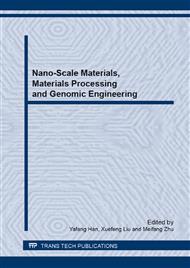p.344
p.350
p.355
p.362
p.370
p.377
p.384
p.391
p.396
Physical Properties, Compatibility and Morphology of Hydrogenated Nitrile Rubber/Fluoroether Rubber Blends
Abstract:
The physical properties, compatibility, and morphology of blends of hydrogenated nitrile rubber (HNBR) with fluoroether rubber were investigated with reference to the blends ratio. The results show that the blends have excellent physical properties. Minimum torque (ML), maximum torque (MH), optimum curing time (t90), compression set, volume and mass change in fluid, and specific gravity are linear with the content of HNBR. On the other hand, MH-ML, hardness and 100% modulus show synergistic effect when the blend ratio is 50/50, indicating that there is some special morphology or interaction between the two polymers. There are two glass transition (Tg) peaks in Tanδ-T, Loss modulus (E")-T and Differential Scanning Caloricity (DSC) curves of the 50/50 blend and the Cole-Cole curve of the 50/50 blend shows two modified semicircles, suggesting the absence of segmental miscibility of the blends. The thermal gravimetric analysis (TGA) curves demonstrate that the 50/50 blend is thermo-stable to the highest temperature which may be due to the interaction between the two materials. Scanning electron microscope (SEM) was used to investigate the morphology of the blends. The micrographs of 75/25 and 25/75 HNBR/fluoroether rubber blends have phase separated structures with the Sea-Island morphology. For the 50/50 blend, the SEM micrographs show a co-continuous morphology, which is suggested to be the reason for the synergistic effects of MH-ML, hardness, and the 100% modulus at the given ratio. In conclusion, the physical properties, DSC, TGA, dynamical mechanical thermal analysis, and SEM micrographs agree in suggesting that the HNBR and fluoroether rubber are not thermodynamically miscible but mechanically compatible.
Info:
Periodical:
Pages:
370-376
Citation:
Online since:
April 2014
Authors:
Price:
Сopyright:
© 2014 Trans Tech Publications Ltd. All Rights Reserved
Share:
Citation:


